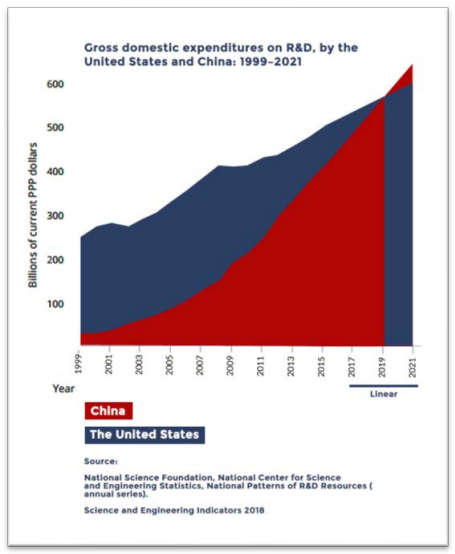The AI Arms Race: How US And China Outpaced Middle Eastern Competitors

Table of Contents
US AI Leadership: Technological Advantage and Private Sector Investment
The US holds a commanding lead in the AI arms race, fueled by a powerful combination of superior research and development, a robust private sector ecosystem, and the ability to attract and retain top AI talent globally.
Superior Research and Development
US universities and research institutions are consistently at the forefront of AI innovation.
- Leading Universities: Stanford, MIT, Carnegie Mellon, and Berkeley consistently produce groundbreaking AI research and nurture future AI leaders.
- Government Funding: Agencies like DARPA (Defense Advanced Research Projects Agency) and the NSF (National Science Foundation) provide substantial funding for cutting-edge AI research, driving advancements in areas like machine learning and deep learning.
- Private Sector Investment: Significant private sector investment fuels AI startups and major tech corporations like Google, Microsoft, and Amazon, fostering rapid innovation and product development.
Robust Private Sector Ecosystem
The private sector plays a crucial role in the US's AI dominance.
- Tech Giants: Google, Microsoft, Amazon, and Facebook (Meta) are investing billions in AI research and development, creating innovative products and services that permeate various aspects of daily life. Think of Google's search algorithms, Amazon's recommendation engines, and Microsoft's Azure AI platform.
- Venture Capital: Silicon Valley is a hotbed of venture capital funding for AI startups, providing crucial capital for growth and expansion. This continuous flow of funding ensures a constant pipeline of innovative AI companies.
- Silicon Valley Effect: The concentration of talent, capital, and resources in Silicon Valley creates a self-reinforcing ecosystem that accelerates AI innovation.
Talent Acquisition and Retention
The US successfully attracts and retains top AI talent worldwide.
- Immigration Policies: Historically, relatively open immigration policies have allowed the US to recruit skilled workers from around the globe.
- Competitive Salaries: High salaries and attractive compensation packages incentivize top AI researchers and engineers to work in the US.
- Quality of Life: A high quality of life, diverse culture, and presence of world-renowned universities further enhance the US's appeal to global talent.
China's Rapid AI Ascent: Government Initiatives and Data Abundance
China's rise in artificial intelligence has been nothing short of remarkable, driven by ambitious government initiatives and an abundance of data.
Government-Led Initiatives
The Chinese government has implemented a national AI strategy with substantial investments.
- Made in China 2025: This initiative prioritizes AI development as a key component of China's economic and technological advancement.
- Targeted Funding: Significant government funding programs are dedicated to supporting AI research, development, and deployment across various sectors.
- Regulatory Environment: While the regulatory landscape is evolving, the Chinese government is actively shaping the environment to foster AI growth.
Massive Data Availability
China possesses a vast trove of data that fuels AI algorithm training.
- E-commerce Data: The massive scale of Chinese e-commerce platforms generates enormous datasets for AI applications like recommendation systems and targeted advertising.
- Surveillance Data: China's extensive surveillance infrastructure provides access to large datasets, although this raises significant privacy concerns.
- Data Infrastructure: Investments in data infrastructure, including high-speed internet and cloud computing, are crucial for processing and utilizing this data.
Focus on Specific AI Applications
China has concentrated its AI efforts on specific applications.
- Facial Recognition: China is a global leader in facial recognition technology, with applications ranging from security to law enforcement.
- AI-Powered Surveillance: The use of AI for surveillance and social control is another area of significant focus, raising ethical questions about privacy and individual liberties.
- Successful Applications: China has seen numerous successes in applying AI to various sectors, such as finance, transportation, and manufacturing.
Middle Eastern Challenges in the AI Arms Race: Hurdles to Overcome
The Middle East faces substantial challenges in closing the gap in the global AI race.
Lack of Investment
Investment in AI research and development in the Middle East remains significantly lower than in the US and China.
- Investment Gap: A stark contrast exists between the billions invested in AI in the US and China versus the comparatively modest investments in the Middle East.
- Reasons for Underinvestment: Factors contributing to underinvestment include a lack of awareness of AI's potential, limited risk capital, and a focus on other economic priorities.
Talent Shortage
A severe shortage of skilled AI professionals hinders Middle Eastern AI development.
- Lack of Educational Programs: The region needs to expand its higher education programs in AI-related fields to cultivate local talent.
- Brain Drain: Highly skilled individuals often seek opportunities abroad, leading to a loss of talent within the region.
- Attracting International Talent: The Middle East faces competition from other regions in attracting international AI experts.
Infrastructure Limitations
Insufficient infrastructure hampers the development and deployment of AI systems.
- Computing Power: The Middle East needs substantial investments in high-performance computing infrastructure.
- Data Centers: A lack of advanced data centers capable of handling the massive datasets required for AI limits progress.
- Digital Divide: Bridging the digital divide within the region is crucial to ensure equitable access to the resources needed for AI development.
Policy and Regulatory Frameworks
Supportive government policies and clear regulatory frameworks are essential for fostering AI growth.
- Attracting Investment: The region needs to develop policies that attract foreign and domestic investment in AI.
- Talent Acquisition Policies: Policies are needed to encourage the return of skilled individuals and attract foreign talent.
- AI Ethics Regulations: Clear regulatory guidelines for ethical AI development and deployment are crucial to building public trust.
Conclusion: Bridging the AI Gap in the Middle East
The AI arms race highlights the significant lead of the US and China, underscoring the challenges facing the Middle East in this critical technological domain. To bridge this gap, the region must prioritize increased investment in AI research and development, foster a robust ecosystem for AI startups, and cultivate a skilled workforce through targeted educational programs. Strong government policies that attract both foreign and domestic investment are essential, along with clear regulatory frameworks that address ethical concerns and build public trust. Understanding the AI arms race is crucial. Invest in AI education, advocate for supportive government policies, and help close the gap between the Middle East and global AI leaders. The future of the Middle East’s economic competitiveness and global influence hinges on successfully navigating this global artificial intelligence competition.

Featured Posts
-
 March 27th Cavaliers Spurs Game Complete Injury Report From Fox Sports 1340 Wnco
May 07, 2025
March 27th Cavaliers Spurs Game Complete Injury Report From Fox Sports 1340 Wnco
May 07, 2025 -
 Chestit Rozhden Den Dzheki Chan 71 Godini Izplneni S Ekshn
May 07, 2025
Chestit Rozhden Den Dzheki Chan 71 Godini Izplneni S Ekshn
May 07, 2025 -
 Rare Sighting Lewis Capaldi Gives Thumbs Up In Public
May 07, 2025
Rare Sighting Lewis Capaldi Gives Thumbs Up In Public
May 07, 2025 -
 Tigers Vs Mariners Mlb Game Prediction Expert Picks And Betting Odds
May 07, 2025
Tigers Vs Mariners Mlb Game Prediction Expert Picks And Betting Odds
May 07, 2025 -
 Notre Dame Alumnae Wnba Stars Return For Preseason Game
May 07, 2025
Notre Dame Alumnae Wnba Stars Return For Preseason Game
May 07, 2025
